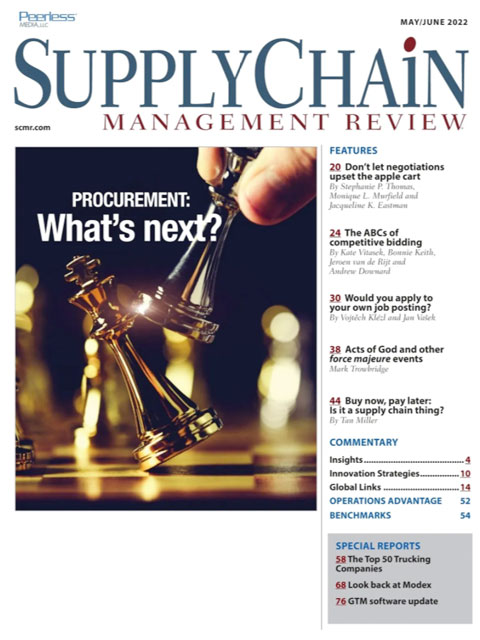Sorry, but your login has failed. Please recheck your login information and resubmit. If your subscription has expired, renew here.
May-June 2022
I recently returned from three days in Atlanta at the Modex trade show. Although advertised as a supply chain event, it’s really a materials handling automation show with a handful of logistics providers thrown in for good measure. Heading out the door to the airport, I had no idea what to expect. The two-year absence from the trade show and conference scene had me, and many of the individuals I spoke to before the show opened, wondering what’s next—not just for the show but for operations in general. If the turnout and the enthusiasm is any indication, I think supply chain is in pretty good shape these days, despite the disruptions we’ve… Browse this issue archive.Need Help? Contact customer service 847-559-7581 More options
There’s no debate that cost effective sourcing contributes to a strong bottom line, yet businesses are currently facing many challenges to effective procurement and operations. Still, in many cases, resistance to change and corporate inertia result in organizations continuing to use highly distributed and “non-synergistic” systems. Even more challenging is the case of mergers/acquisitions, where corporations maintain existing systems to provide an illusion of a “business-as-usual” feel to internal stakeholders.
CPOs and CFOs across organizations, irrespective of size, type of business or growth strategies, need to align procurement with the vision of their organization. The most critical issues are disparate focus and incongruous strategies. The decision process for effective sourcing can not only be complex, but daunting. Critical to success is the decision related to the degree of centralization required within the procurement organization.
Centralized procurement lends a strategic advantage to organizations through economies of scale and collective buying power. However, in some cases a federal, coordinated or center-led structure works better. These models allow individual business units to act autonomously and minimize corporate overhead. However, due to lack of coordination each unit may end up with different prices and contractual conditions for the same supplies. How organizations can define their procurement models is a
critical process.
Another challenge to securing effective sourcing is to create the right technological support for the supply chain. Distributed systems lead to technological challenges hampering organizations in their efforts to leverage cloud technology to their benefit. When creating common procurement systems, organizations need to choose the right technological platform and IT systems. The system needs to be flexible enough to ensure that variances in locations, regulations and categories are fully accounted for.
The right approach is to acquire a thorough understanding of the organizational dynamics affecting effective procurement. In our experience, an approach to innovation, as shown in Figure 1, requires an in-depth analysis of target elements, and a study of industry best practices and benchmarking. The results of the analysis are used to create a synergetic approach that aligns procurement goals with the organization’s goals.

This complete article is available to subscribers only.
Log in now for full access or start your PLUS+ subscription for instant access.
SC
MR
Sorry, but your login has failed. Please recheck your login information and resubmit. If your subscription has expired, renew here.
May-June 2022
I recently returned from three days in Atlanta at the Modex trade show. Although advertised as a supply chain event, it’s really a materials handling automation show with a handful of logistics providers thrown in… Browse this issue archive. Access your online digital edition. Download a PDF file of the May-June 2022 issue.There’s no debate that cost effective sourcing contributes to a strong bottom line, yet businesses are currently facing many challenges to effective procurement and operations. Still, in many cases, resistance to change and corporate inertia result in organizations continuing to use highly distributed and “non-synergistic” systems. Even more challenging is the case of mergers/acquisitions, where corporations maintain existing systems to provide an illusion of a “business-as-usual” feel to internal stakeholders.
CPOs and CFOs across organizations, irrespective of size, type of business or growth strategies, need to align procurement with the vision of their organization. The most critical issues are disparate focus and incongruous strategies. The decision process for effective sourcing can not only be complex, but daunting. Critical to success is the decision related to the degree of centralization required within the procurement organization.
Centralized procurement lends a strategic advantage to organizations through economies of scale and collective buying power. However, in some cases a federal, coordinated or center-led structure works better. These models allow individual business units to act autonomously and minimize corporate overhead. However, due to lack of coordination each unit may end up with different prices and contractual conditions for the same supplies. How organizations can define their procurement models is a
critical process.
Another challenge to securing effective sourcing is to create the right technological support for the supply chain. Distributed systems lead to technological challenges hampering organizations in their efforts to leverage cloud technology to their benefit. When creating common procurement systems, organizations need to choose the right technological platform and IT systems. The system needs to be flexible enough to ensure that variances in locations, regulations and categories are fully accounted for.
The right approach is to acquire a thorough understanding of the organizational dynamics affecting effective procurement. In our experience, an approach to innovation, as shown in Figure 1, requires an in-depth analysis of target elements, and a study of industry best practices and benchmarking. The results of the analysis are used to create a synergetic approach that aligns procurement goals with the organization’s goals.
SC
MR


Latest Supply Chain News
Latest Podcast

 Explore
Explore
Business Management News
- Strategic cost savings differ from cutting costs
- Planning fatigue may be settling in
- Inflation, economic worries among top supply chain concerns for SMBs
- April Services PMI declines following 15 months of growth, reports ISM
- Attacking stubborn COGS inflation with Digital Design-and-Source-to-Value
- Joseph Esteves named CEO of SGS Maine Pointe
- More Business Management
Latest Business Management Resources

Subscribe

Supply Chain Management Review delivers the best industry content.

Editors’ Picks






